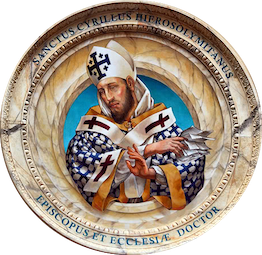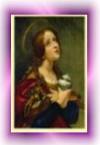His writings are of great importance since he is a Father of the Church and Archbishop of Jerusalem only three centuries after the passion of Jesus. He succeeded Maximus in the See of Jerusalem in the year 248 and was bishop of this city for 35 years. As a result of his defense of orthodoxy in the Arian controversy, he was exiled to the desert more than once. We have 18 catechetical discourses, a sermon from the shore of Bethsaida, a letter to the Emperor Constantine and a few other fragments of his writings that have survived to the present day. Three writings are dedicated to the general exposition of doctrine and five, called mystogogues, are dedicated to commentary on the sacramental rites of Christian initiation.
These writings, called the Catechesis of Saint Cyril, come to us thanks to the transcription of a stenographer, who wrote them with the same simplicity and naturalness of Saint Cyril when he was communicating them to the Christian community in the three principle sanctuaries of Jerusalem. Among them was the Basilica of the Holy Cross of Constantine, called Martyrion for the candidates for Baptism, and the Church of the Resurrection, also called Anastasis, in order that those that were to be baptized during the week of Easter could not only listen, but ‘see and touch’ the same places where the redemption had occurred. Through these important writings, which were probably composed at the beginning of his episcopate, he was given the title of Doctor of the Church by Pope Leo XIII. There was some uncertainty regarding his theological thought, which delayed his recognition in the west, but his holiness was recognized. His feast was instituted in 1882.
He had some sympathy for the Arians, but quickly separated from them in order to adhere to semi-arian homoiusius thinking, that is, the theological orientation that was inclined to the agreements that proposed the term “homoi-ousious (of a similar nature) in place of “homo-ousius” (of the same nature, that the Word is of the same nature as the Father). It was dealt with by only adding one letter, but it was enough to eliminate the idea of consubstantiality (consubstantial: that it is of the same substance) between the Father and the Son. Cyril also abandoned the semi-arians and united himself with the orthodox doctrine of Nicaea, and was exiled five times under the Emperors Constantine and Valens as a result, 16 years of exile in total, three times by one group and twice by the other.
In his writings he speaks of penitence, sin, Baptism and the Creed, explaining it phrase by phrase, in order to instruct the recently baptized about the faith. He also speaks beautifully about the Eucharist, insisting strongly that Jesus Christ is truly present in the Sacred Eucharistic Host. To those who received the Eucharist in the hand he advised, “Make your left hand like a throne to support your right hand in order to receive the Celestial King. Treat the consecrated host with great care, ensuring that pieces do not fall on the ground, as we would not let pieces of gold to fall to the ground.” In synthesis, these documents are of great value because they contain teachings and rites of the Church of the fourth century and they form “the primitive theological system”. Also they describe very interestingly the discovery of the true Cross and the rock that covered the Holy Sepulcher.
Two versions of the story of why Cyril succeeded Maximus in the See of Jerusalem exist which do not agree. One of them was left us by Saint Jerome, who evidently had a prejudice against Saint Cyril. Acacius, an Arian, one of the Bishops of the province, legally consecrated Saint Cyril Bishop, thinking then that he would be able to manage it, but he was completely mistaken. Cyril was a man of soft character, preferring to instruct rather than be polemical, he tried to stay neutral in discussions and for this reason both sides abandoned him in a moment, calling him a heretic. However, he had friends like Saint Hilary, defender of the Dogma of the Holy Trinity, and Saint Athanasius, who defended the divinity of Jesus Christ, with whom he kept a sincere friendship. In the Council of Constantinople in 381, they called him, “valiant fighter to defend the Church against the heretics that deny the truths of our religion”.
In the first year of his Episcopate, a physical phenomenon occurred that impressed the city. He sent notice of what had happened to the Emperor Constantine, in a letter that still exists, though its authenticity has been shadowed by doubt, although the style is undoubtedly his. The letter says, “On the ninth of May, around the third hour, a large illuminated Cross appeared in the sky on top of Golgotha that extended to the Mount of Olives: it was not seen by only one or two people, but rather was very evident and was clearly seen by all the city. This was not, as one might believe, a fantasy nor a momentary apparition, but remained visible to our eyes for several hours and was brighter than the sun. The entire city was filled with fear and delight at the same time before such a wonder, running immediately to the Church and praising Jesus Christ the only Son of God.”
As soon as Cyril has taken possession of the See, the discussions between him and Acacio began, not only of the problems of their respective Sees, but also regarding matters of faith, because Acacio was involved in the Arian heresy. Acacio, as metropolitan of Caesarea, demanded the jurisdiction of Cyril maintain the priority of his See, as if it was an “apostolic throne”. Acacio remembered a canon of the Council of Nicaea that says, “Since through custom or ancient tradition, the Bishop of Aelia (Jerusalem) ought to receive honor, we leave the metropolitan (of Caesarea) in his own dignity to maintain the second place”.
The quarrel had begun and Acacio convoked a Council of Bishops sympathetic to him, and they summoned Cyril, but he never presented himself. He was accused of stubbornness (obstinacy, persisting in error) and of having sold properties of the Church to help the needy. In the end, if he did do it, as many prelates had done before, including Saint Ambrose and Saint Augustine, and it was understandable. The fraudulent Council condemned Cyril and he was exiled from Jerusalem. He went to Tarsus, where he was received by the semi-Arian Bishop Silvanus received him, and waited there for the appeal he has made to a higher tribunal. Two years later, before the Council of Seleucia, the his appeal arrived. This Council brought together semi-Arians, Arians, and a very few members of the orthodox side, all from Egypt. Cyril sat with the semi-Arians who had helped him during his exile. Acacius left the meeting, violently objecting to the presence of Cyril, but returned later to participate in the later debates. The party of Acacio was deposed, being in the minority, and Cyril was vindicated.
Acacius went to Constantinople to try to convince Constantine to call another council. He accused Cyril of having sold the vestments that the Emperor had given to Macarius to administer Baptism in and used the money to go see a theatrical production. This made the Emperor furious, and he put forth a second decree of exile against Cyril, only one year after having regained his See. Constantine died in the year 361 and was succeeded by Julian, who called for all the Bishops who Constantine had exiled to return, and thus Cyril regained his See. During the reign of Julian the Apostate there were few martyrdoms in comparison with the other rulers, but this is due to the fact that he realized that the blood of the martyrs is the foundation of the Church and, therefore, he did all he could to discredit the religion that he had abandoned. Historians of the Church, Socrates, Theodorus and others, tell us that Julian planned to reconstruct the temple of Jerusalem in order to appeal to the national sentiment of the Jews and in order to demonstrate that the things Jesus had announced in the Gospel would not be accomplished. Saint Cyril calmly contemplated the preparations for the reconstruction of the temple, prophesying that it would be a failure, and thus it happened. Gibbon and other agnostics were amazed at the supernatural events, earthquakes, balls of fire, collapsing walls, ect. They decided to abandon the Project, but Gibbon admitted that these vents were confirmed not only by Christian writers, like St. John Chrysostom and St. Ambrose, but also by the testimony of Ammianus Marcellinus, a soldier philosopher, who was a pagan.
Saint Cyril was exiled a third time by Valens in the year 267, together with all the prelates named by Julian. This final exile lasted for 11 years, but when Theodorus ascended to the throne, he was reinstated in his See, where he remained for the last years of his life. Saddened by all the evil he found in Jerusalem, the vice, disorder, heresies, division, ect., he appealed to the council of Antioch. They sent St. Gregory of Nyssa, who was not able to remedy anything and abandoned Jerusalem, leaving for posterity his, “Warning against pilgrimages”, a detailed description of the moral of the city of that time.
Cyril and St. Gregory were present at the great Council of Constantinople (the first ecumenical council in which Cyril participated), which was the second ecumenical council of the Church. On this occasion Cyril, Bishop of Jerusalem together with the Patriarchs of Alexandria and Antioch, taking his place as a metropolitan, the legitimacy of his episcopate was recognized. This council promulgated the Nicene Creed, in its corrected form. Cyril and the others accepted the term “homo-ousios”, which came to be the key Word for orthodoxy. Socrates and Sozomen took this act as one of repentance. For their part, the Bishops wrote a letter to Pope St. Damascene, where they hail Cyril as one of the defenders of true orthodoxy against the Arians.
It is believed that Cyril died in Jerusalem in 386 at the age of 72.

